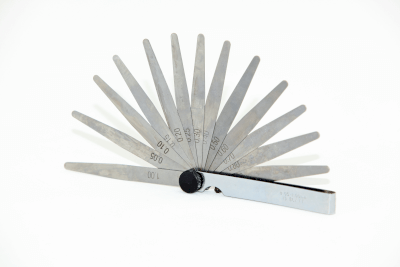What Is a Cutter Clearance Gauge?

A cutter clearance gauge is a rectangular-shaped plate that is inserted into a gap between parts or products to measure the size of the gap. It is sometimes called a thickness gauge. The term “thickness gauge” is also used for a measuring instrument that measures the thickness of an object by pinching it, so care should be taken not to confuse the two. A single thin plate is called a leaf, and a bundle of several leaves of different thicknesses is called a combination leaf.
Uses of Cutter Clearance Gauges
Cutter clearance gauges are used to measure narrow gaps that cannot be measured with calipers. Basically, they are suitable for measuring the clearance between parallel surfaces, and cannot measure the clearance between cracks, for example. It is used to measure the skimmer between the base of a unit when assembling it, between a door and the door frame, between a reference position and a part when installing and adjusting a part, and between a piston and a cylinder. There are both metric and inch types of cutter clearance gauges. Metric cutter clearance gauges are commercially available in thicknesses from 0.01mm leaf. The use of cutter clearance gauges makes it possible to measure small gaps that cannot be measured with other tools.
Features of Cutter Clearance Gauges
Cutter clearance gauges are characterized by the ability to measure small skimmers easily. Measurement can be made using only one leaf, but it is also possible to stack multiple leaves. However, it should be noted that stacking multiple leaves results in a slight loss of accuracy. Leaf sizes can be measured from a gap as small as 0.01mm. However, it should be noted that thin leaves tend to be crumpled and folded, making it impossible to obtain a correct measurement.
Two types of leaf shapes are specified. Type A has a constant leaf width and is stronger than Type B because only the tip of the leaf is rounded. Type A is usually used when there is sufficient space in the skimmer to be measured, while Type B gradually narrows the leaf width to about half the width at the tip. Type B is used when measuring narrower skimmers, but it is less strong than Type A, so care must be taken to avoid bending.